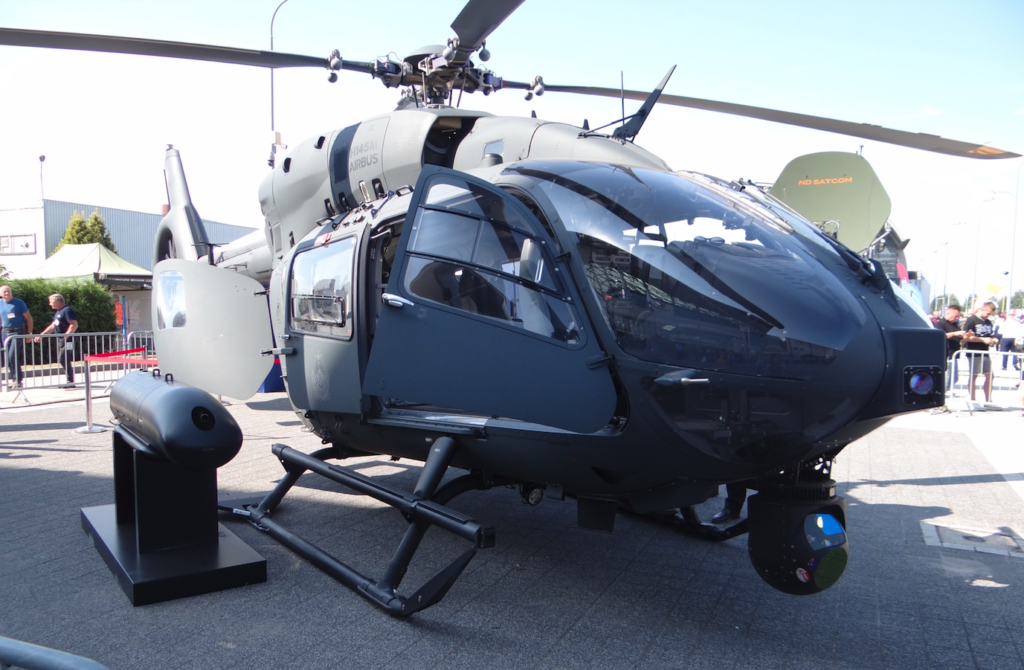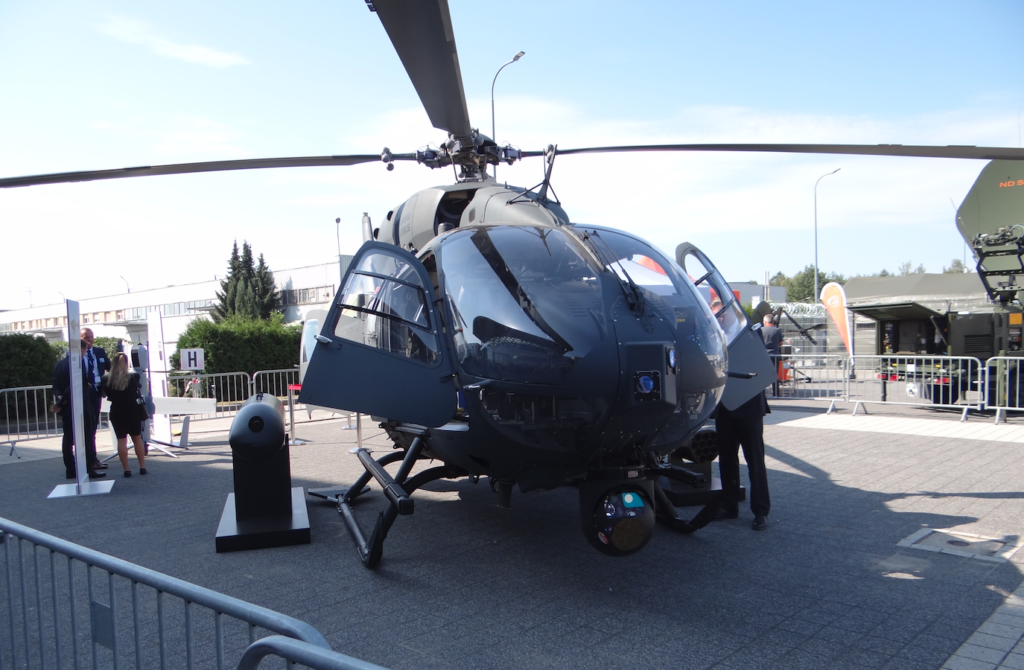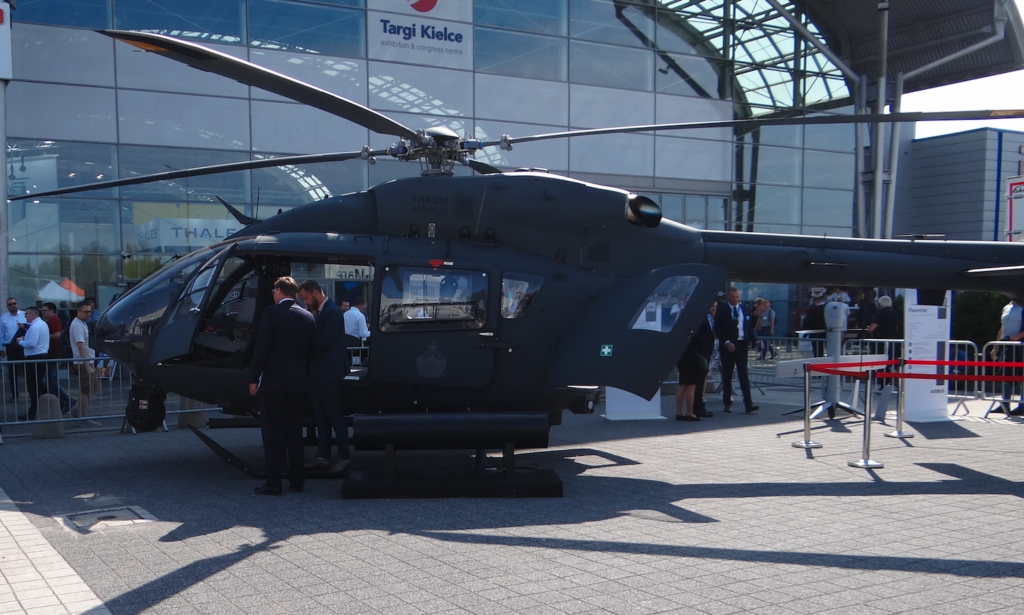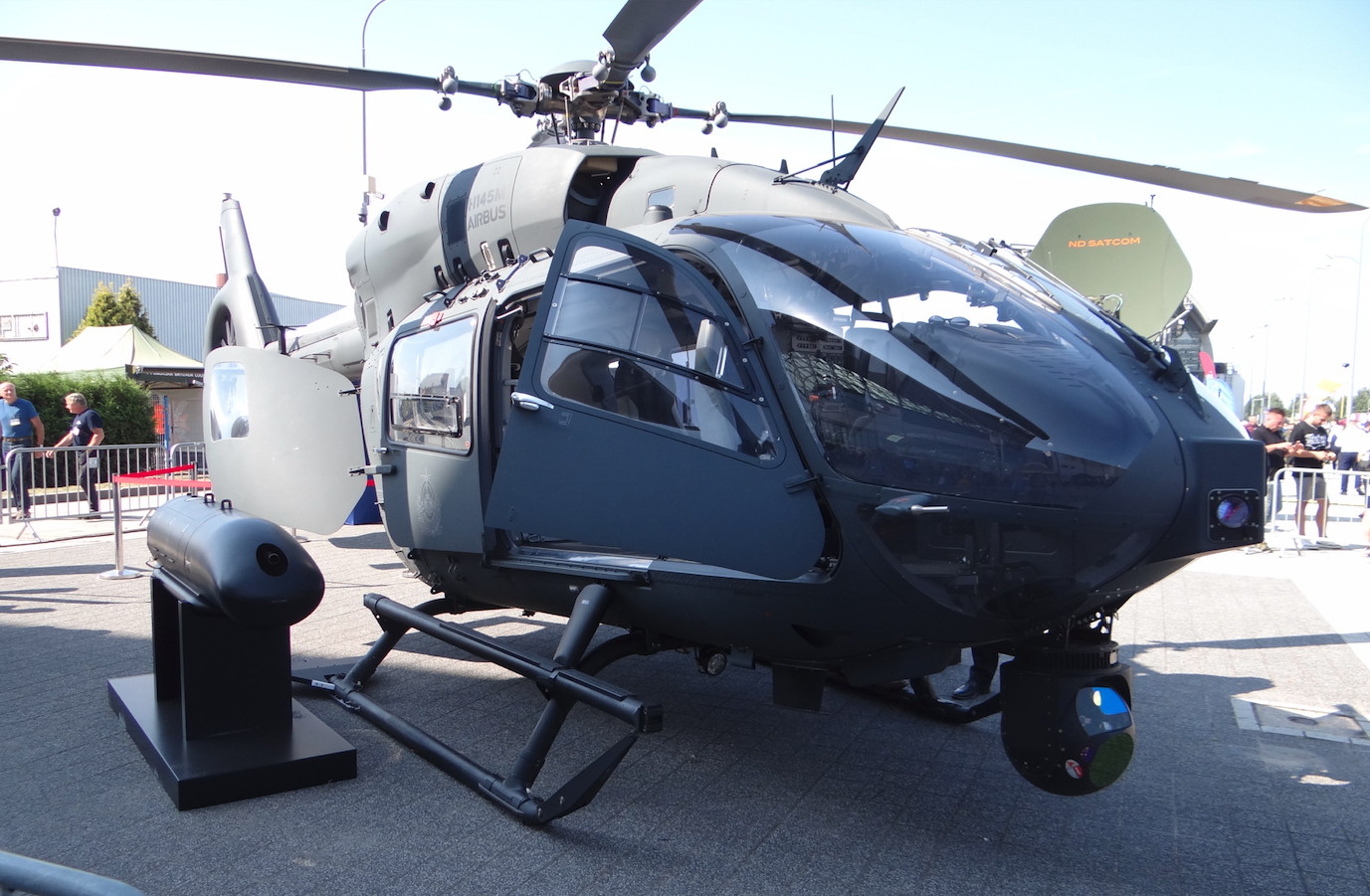Kielce 2025-01-14
Airbus Helicopters H-145.
The Airbus Helicopters H-145 is a light, twin-engine, multi-role helicopter, currently produced by Airbus Helicopters. First, it should be noted that the helicopter has several designations, which are closely related to the organizational changes in the European helicopter industry. Initially, the helicopter was designated BK-117, then Eurocopter EC-145, and currently Airbus Helicopters H-145.



In the 1990s, MBB and Kawasaki Aerospace Company began work on the helicopter. Later, MBB became part of Eurocopter, and then Airbus Helicopters. The new helicopter received the designation BK-117, or Bolkow – Kawasaki. The prototype of the helicopter was flown on June 12, 1999. Then the helicopter received the designation Eurocopter EC-145, and in 2015, finally received the designation Airbus Helicopters H-145.
Airbus Helicopters H-145 is a light helicopter that received two turbine engines as a drive. The helicopter layout is classic, i.e. Sikorsky layout. The helicopter has many common elements with the original BK-117 and EC-135. The main assumption of the designers was to increase the payload and range of the helicopter. The aim was to reduce vibration and noise. Additionally, they wanted to reduce the costs of operation and maintenance.
In December 1997, the H-145 helicopter (then BK-117 C2), received a certificate and was selected by France as a helicopter for coastal defense and civil guard. A total of 31 EC-145 helicopters were ordered, replacing the old Aérospatiale Alouette III helicopters. The first EC-145 made its maiden flight in Donauwörth, Germany, on 12 June 1999. The EC-145 helicopter received FAA certification in January 2002. In 2001, Eurocopter and Kawasaki entered into an agreement to independently manufacture and sell helicopters. The cooperation was limited to research and development. Kawasaki retained the BK-117 C2 designation and sells the helicopters on the Asian market. Eurocopter sells EC-145 helicopters worldwide, under the EC-145 designation, and since 2015, under the H-145 designation.
In 2011, Eurocopter introduced an improved EC-145 model, designated EC-145 T2. The EC-145 T2 helicopter has improved performance through the use of new turbine engines, designated Arriel 2E, which received a Full Authority digital control system. The tail rotor design introduced Eurocopter’s Fenestron system. New avionics, glass cockpit and 4-axis autopilot were introduced. In April 2014, the EC-145 T2 helicopter received European certification, and in October 2014, it received FAA certification. The helicopter is produced for the military and civilian markets. The helicopter can transport up to 9 people, including the pilot, can be used for medical transport (EMS), search, rescue, paramilitary tasks. Military variants are produced under different designations, for example H-145 M or UH-72. In the military, helicopters are used for training, transport, logistic tasks, medical evacuation, reconnaissance, patrolling and even for assault tasks.
In 2022, the H-145 helicopter was offered to Poland as a successor to the PZL Mi-2 helicopters. The H-145 helicopter is still offered.
The H-145M helicopters offered by Airbus are conquering new markets. So far (2024), the manufacturer has delivered 1,650 H145s to users around the world. The fleet of these helicopters has flown over 7.6 million hours. Currently, the manufacturer supplies machines in a configuration with a five-blade main rotor, which allows for an increase in lifting capacity by 150 kg. Other design changes have made it possible to reduce the labor intensity of ground service and also increased the reliability of the structure.
During the International Defense Industry Exhibition (MSPO) 2024 held in Kielce on September 3-6, 2024, Airbus presented the multi-role H-145M helicopter belonging to the Hungarian Air Force. It was one of nineteen series helicopters operated in Hungary. The presence of the helicopter in Kielce was related to a possible contract for the purchase of 24 helicopters for the 4th Training Aviation Wing. However, currently, under the rule of the Volksdeutsche, communists and freemasons, the possible tender has been suspended. In January 2024, the Armament Agency announced initial market consultations on the integrated training system for combat helicopter pilots, which was to include, among other things, the purchase of 24 new-generation helicopters. The new helicopters would replace the PZL SW-4 Puszczyk and PZL Mi-2 helicopters in the structures of the 4th Training Aviation Wing. In the Polish Army, the problem is already burning at present (2024), due to the purchase of 96 Boeing AH-64E Apache combat helicopters and the continued deliveries of Leonardo AW149 multi-role helicopters. The current (2025) Ministry of National Defense still maintains its declarations regarding the purchase of more helicopters. But their words are worthless. The government says one thing and yet demolishes Poland; the Polish Army, the Police, the Fire Department, education, and especially the economy. As recently as 2018, various versions of the PZL Mi-2 helicopter were still in service with the Polish Army. However, this is not due to their effectiveness, but rather to the lack of a sufficient number of successors. Neither the PZL Sokół nor the PZL Puszczyk were ordered by the Polish Army in sufficient quantities. In addition, the few Mil Mi-24s exhausted their supplies of guided missiles in 2016. The reasons for this state of affairs should be sought in the long-term underinvestment in the Polish Armed Forces, which was associated with the rolling over of the Republic of Poland by post-communist and Masonic-liberal governments.
The military versions of the PZL Mi-2 were always a substitute for a battlefield helicopter. Structurally, it was still a multi-role helicopter, devoid of any armor. Neither the crew, nor the fuel tank, nor the engines were armored. Their success depended primarily on the tactics of use. Since the helicopter is small, it is not such an easy target. Its relatively high speed and maneuverability are its advantages. Intensive training of Polish pilots in flights at low and very low altitudes partially neutralized the machine’s shortcomings. Performing sharp “hills” for an attack and sharp turns after an attack was the daily bread of our pilots. They undoubtedly tried to perform their tasks with full professionalism.
However, a regular attack on the Mi-2, even with a light machine gun, can end in the downing of the machine. The crews only have military helmets, or bulletproof vests. The use of rescue parachutes is pointless, because helicopters operate at low altitudes. When the Mi-2 was designed, no one thought about the main rotor blades being shot off and ejection seats.
The design of the H-145 helicopter.
The helicopter was built in a classic layout, with a rotor equipped with 5-composite blades, and the tail boom uses Fenestron, which was developed by Eurocopter. The helicopter has a skid undercarriage. The fuselage of the helicopter is equipped with a double-winged door at the rear and two pairs of doors on the sides. The doors to the cargo bay are moved backwards, which allows the use of a winch.
The helicopter presented in the photos has been designated H-145 M. The cargo bay equipment is typically medical. On the other hand, light weapons are suspended on external suspensions. An opto-electronic head is mounted under the fuselage of the helicopter.
T-T data of the H-145 helicopter:
Crew 2 people. Cargo bay capacity up to 9 people or 1,793 kg (3,953 lb) of cargo. Length 13.03 m (42 ft 9 in). Height 3.45 m (11 ft 4 in). Empty weight 1,792 kg (3,951 lb). Gross weight 3,585 kg (7,904 lb). Fuel capacity 723.0 kg (1,593.9 lb). Powerplant 2 Turbomeca Arriel 1E2 turbine engines, each of 550 kW (740 hp). Main rotor diameter 11 m (36 ft 1 in). Cruise speed 246 km/h (153 mph, 133 knots). Range 680 km (420 mi, 370 nautical miles). Ferry range 855 km (531 mi, 462 nautical miles). Service ceiling 5,240 m (17,190 ft). Rate of climb 8.1 m/s (1,590 ft/min).
Written by Karol Placha Hetman

